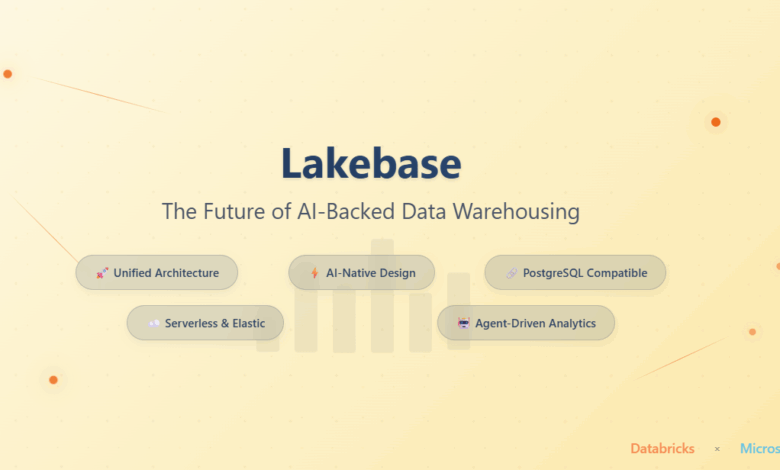
How Lakebase marks a new era in AI-Driven Analytics
Key Takeaway:
Databricks’ Lakebase marks the start of a new era in data architecture, it is trying to carefully merge the reliability and robustness of traditional databases with the scalability and ease of use of modern data lakes. With partnerships with industry leaders like Microsoft and many retail clients already reaping the benefits and bringing the product closer to a wider audience, Lakebase is becoming the operational backbone of AI agents and AI-backed applications. It is also aggressively spearheading the revolution in the AI/BI dashboarding space through implementing natural language processing in dashboards and making it more autonomous for end users.
The data warehousing landscape is undergoing a major transformation. For years, industries have suffered and found it hard to prioritize between an operational database designed for transaction processing or a cloud based analytical system built for business intelligence. Databricks seems to have launched Lakebase to address this issue and is making its way towards the launch of a new generation of data architecture that intends to redefine the current way of storing processing and analyzing data.
Cross-functional Data Architecture
Traditional OLTP (online transaction processing) databases have proven to be expensive and inefficient when it comes to building an ETL pipeline around them. These legacy systems separate operational and analytical workloads. These systems get complicated when complex ETL pipelines are built around it. Lakebase comes to rescue and proposes to solve this problem.
Lakebase brings a new age architecture that separates computing and storage. It enables independent scaling while supporting low latency(<10ms) and high concurrency transactions (>10k). Built on Postgres standard, it eliminates vendor lock-in while providing cloud elasticity and cost efficiency.
AI integrated Data Architecture
Lakebase represents the birth of an entirely new category, redefining separation of storage and computing, flexibility, serverless capabilities and AI agent integration. This was done to address the growth and cater to the AI applications that require more operational speed and analytical depth.
According to Databricks, there was an increase in agent-created databases from 30% to 80% this year, indicating modern architecture like Lakebase catering to this demand.
Microsoft Partnership: Huge opportunity of enterprise-wide adoption
In June 2025, Microsoft announced a multi-year extension with Databricks, providing Lakebase a great platform to showcase its enterprise and industry wide capabilities.
With over 15,000 organizations worldwide, including over 60% of the Fortune 500—already using and consuming Databricks platforms, the Microsoft partnership provides further enables various stakeholders prioritizing and adapting to AI-driven transformation.
The Evolution of AI-Powered Dashboarding
Lakebase brings about massive disruption in the traditional business intelligence industry. The future of BI goes beyond traditional static reports and apps and is rapidly headed towards an AI-driven interface that makes data accessible to everyone.
Major BI vendors have started implementing generative AI and natural language processing, allowing non-technical users to ask questions in simple language and receive instant insights. Business users can now ask dashboards questions like “What are our top performing sales region last quarter?” and receive detailed answers without having to navigate a dashboard or having someone explain it to them from the technical team.
AI/BI dashboards with proper training can generate helpful insights and charts as requested by the end user without requiring prior technical expertise.
Autonomous Analytics and Agent-Driven Insights
AI Agents are here, and they are very much capable of writing and executing queries and performing simple analytics. Agentic AI can perform various tasks independently and is a trending topic in the current year. These agents are expected to monitor business metrics and KPIs, identify anomalies and generate insights without any human intervention.
There has been a rise in the “headless BI architecture”, where KPI definitions are not embedded in reports but are calculated via clean architectures accessible via APIs, paving the way for an agent-driven future.
Real-Time and Predictive Analytics
Business intelligence along with AI capabilities will help lead the way towards generating real time predictive analytics. Forecasting and prediction analytics is very common in any industry. These insights help businesses make significant business decisions. AI/BI dashboards are intended to generate such business insights with little to no technical expertise from the user side and thus enabling easy consumption of data stories.
Conclusion
The recent launch of Lakebase by Databricks aims to bridge the gap between operational and analytical systems, Lakebase aims to enable organizations to build unified data architecture that are capable of hosting various AI applications with ease.
The Microsoft partnership amplifies this potential through enterprise level distribution and integration. As AI powered dashboarding is evolving in a rapid pace and enabling intelligent analytics, Lakebase provides the operational backbone required to support these capabilities.
For organizations, the unified architecture is going to come as a saving grace that seamlessly blends operational and analytical workloads, while supporting AI driven automation.





